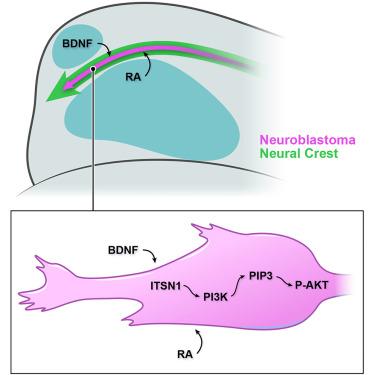Developmental Cell ( IF 11.8 ) Pub Date : 2021-10-04 , DOI: 10.1016/j.devcel.2021.09.014 Randall W Treffy 1 , Sriivatsan G Rajan 1 , Xinghang Jiang 1 , Lynne M Nacke 1 , Usama A Malkana 1 , L A Naiche 2 , Dani E Bergey 1 , Dianicha Santana 3 , Vinodh Rajagopalan 4 , Jan K Kitajewski 2 , John P O'Bryan 5 , Ankur Saxena 1

|
Neuroblastoma (NB), the most common cancer in the first year of life, presents almost exclusively in the trunk. To understand why an early-onset cancer would have such a specific localization, we xenotransplanted human NB cells into discrete neural crest (NC) streams in zebrafish embryos. Here, we demonstrate that human NB cells remain in an undifferentiated, tumorigenic state when comigrating posteriorly with NC cells but, upon comigration into the head, differentiate into neurons and exhibit decreased survival. Furthermore, we demonstrate that this in vivo differentiation requires retinoic acid and brain-derived neurotrophic factor signaling from the microenvironment, as well as cell-autonomous intersectin-1-dependent phosphoinositide 3-kinase-mediated signaling, likely via Akt kinase activation. Our findings suggest a microenvironment-driven explanation for NB’s trunk-biased localization and highlight the potential for induced differentiation to promote NB resolution in vivo.
中文翻译:

神经母细胞瘤体内分化排除颅骨肿瘤
神经母细胞瘤 (NB) 是生命第一年最常见的癌症,几乎只出现在躯干。为了理解为什么早发癌症会有如此特定的定位,我们将人类 NB 细胞异种移植到斑马鱼胚胎的离散神经嵴 (NC) 流中。在这里,我们证明人类 NB 细胞在与 NC 细胞向后共迁移时仍处于未分化的致瘤状态,但在共迁移到头部后,分化为神经元并表现出存活率降低。此外,我们证明这种体内分化需要微环境中的视黄酸和脑源性神经营养因子信号传导,以及细胞自主的 intersectin-1 依赖性磷酸肌醇 3 激酶介导的信号传导(可能通过 Akt 激酶激活)。我们的研究结果对 NB 的躯干偏向定位提出了微环境驱动的解释,并强调了诱导分化促进 NB体内分辨率的潜力。



























 京公网安备 11010802027423号
京公网安备 11010802027423号